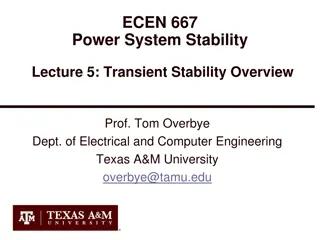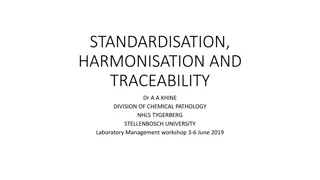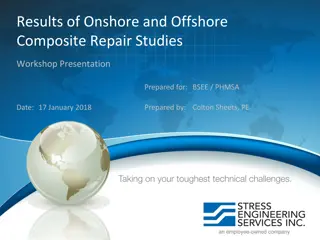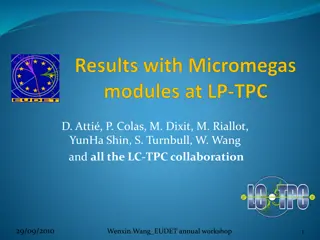
Investigating Mechanical Properties of Silicon Carbide under Heavy Ion Irradiation
This study focuses on investigating the mechanical properties and microstructural changes induced by heavy ion irradiation on Silicon Carbide (SiC) substrates. The research examines the effects of irradiation on hardness and analyzes microstructural variations using Raman spectroscopy, aiming to enhance understanding of SiC's behavior under extreme conditions.
Download Presentation

Please find below an Image/Link to download the presentation.
The content on the website is provided AS IS for your information and personal use only. It may not be sold, licensed, or shared on other websites without obtaining consent from the author. If you encounter any issues during the download, it is possible that the publisher has removed the file from their server.
You are allowed to download the files provided on this website for personal or commercial use, subject to the condition that they are used lawfully. All files are the property of their respective owners.
The content on the website is provided AS IS for your information and personal use only. It may not be sold, licensed, or shared on other websites without obtaining consent from the author.
E N D
Presentation Transcript
Outline Introduction Experimental procedure Results and Discussion Conclusion 2
Introduction South Africa is facing challenges in meeting the growing demand for electricity due to the expanding infrastructure and population, as well as poor utility management. To address the shortage in power generation, nuclear energy is being considered as a viable alternative due to its efficiency and clean nature. High temperature gas cooled reactors such as the Pebble-bed Modular Reactor (PBMR) uses a coated particle fuel technology, and silicon carbide is used as the main diffusion barrier and provides structural intergrity in the Tri-structural Isotropic (TRISO) particles used in PBMR. 3
Introduction Silicon carbide (SiC), is a highly durable material known for its extreme hardness 9.5 moh, making it a key material for high-stress environments, like nuclear reactors and space applications. SiC can be used as radiation shielding material in nuclear systems due to its ability to withstand high-energy radiation, maintaining structural integrity under prolonged radiation exposure. The release of gases from light and heavy atoms during reactor operation leads to the formation of point defects and stress in the protective layers of the TRISO particle, like SiC. The defects and stress induced by these gases have an impact on the SiC structural, chemical and mechanical properties of SiC. Mechanical stability is one of the critical issues governing the long-term performance and reliability of 3C SiC, a substantial analysis of mechanical properties of 3C SiC on the microstructural level is essentially needed. 4
Introduction This study aims to investigate the mechanical properties and microstructural properties induced by 158 MeV Xe26+ swift heavy ion (SHI) irradiation to different fluences on SiC substrates. Our main objectives were to study how irradiation affects the mechanical properties of 3C- SiC, particularly hardness, and to analyze microstructural changes using Raman spectroscopy. 5
Experimental procedure Material used: Polycrystalline (3C) SiC, commercially from Vally Design Corporation. Surface roughness = 0.1 m Density = 3.21 g.cm-3. Cleaning: Chemically cleaned in sonic bath (methanol, diethylene and deionized water). SHI irradiation: Xe26+ ions Energy = 158 MeV Fluence: of 1 1010, 1 1011 and 1 1013 ions.cm-2 at Room temperature. 6
Experimental procedure Analysis: Following irradiation, the samples were analysed using different techniques: Raman spectroscopy: To examine the structural changes induced by irradiation. Nano-indentation Vickers hardness measurements to examine the mechanical properties of SiC before and after irradiation. 7
Stopping and Ranges of Ions in Matter (SRIM) (b) (a) DPA RAD(%) Electronic energy loss(KeV/nm) Nuclear energy loss(KeV/nm) 7x10-5 0,8 1,4x10-6 20 0,7 6x10-5 Electronic energy loss(KeV/nm) Nuclear energy loss(KeV/nm) 1,2x10-6 0,6 5x10-5 1,0x10-6 15 0,5 4x10-5 RAD(%) 8,0x10-7 DPA 0,4 3x10-5 10 6,0x10-7 0,3 2x10-5 4,0x10-7 0,2 5 1x10-5 2,0x10-7 0,1 0 0,0 0 0,0 0 5 10 15 20 0 5 10 15 Depth ( m) Depth(um) Figure 1: (a) The SRIM predicted electron and nuclear energy loss depth profile. The relative atomic density (%) of Xe and displacement per atom (dpa) as a function of depth obtained from SRIM simulations for irradiation to fluences (b) 1 1013 cm-2 8
Raman Spectroscopy Virgin 1x1010 cm-2 1x1011 cm-2 1x1013 cm-2 LO Peak position: TO -767 cm-1 TO-795 cm-1 LO-976 cm-1 Intensity (a.u) TO Intensity ratio of the Transverse optical and Longitudinal optical modes: Unirradiated:0.62 1 1010 cm-2:0.77 1 1011 cm-2 :0.87 1 1013 cm-2:1.09 TO' 500 1000 1500 Raman Shift (cm-1) Figure 2: Raman spectra of CVD SiC before and after Xe irradiation to the fluences of 1x1010cm-2, 1x1011cm-2, 1x1013cm-2. 9
Raman Spectroscopy FWHM 13 FWHM 12 11 1x1013 1x1010 virgin 1x1011 Fluence (cm-2) Figure 3: The fitted Raman Spectra data indicated the FWHM of LO peak. 10
Vickers Hardness Table 1: Vickers hardness measurements before and after irradiation. SAMPLE HARDNESS (GPa) Virgin 29.72 1 1010 cm-2 32.66 1 1011 cm-2 37.28 1 1013 cm-2 30.17 11
Conclusions and Future Work Irradiation introduces damage to the SiC structure, with the most severe damage observed at a fluence of 1 1013 cm-2 . The hardness initially increases at fluences of 1 1010 cm-2 and 1 1011 cm-2 because the defects create stress in the material, making it stronger and more resistant to deformation. At 1 1013 cm-2 , the high concentration of defects causes significant structural damage, reducing the material's ability to handle the applied load and leading to a decrease in hardness. Overall, irradiation at high fluences compromises the hardness and structural integrity of SiC. 12
Conclusions and Future Work Future work: XRD synchrotron radiation can significantly enhance our study by providing high-resolution data that allows for precise identification of phase changes and structural alterations in the material. Its intense and tunable beam enables the detection of subtle changes in lattice parameters and strain, which are critical for understanding the effects of irradiation. 13
Acknowledgements oProf E.G Njoroge oDr T.T Thabethe oPhysics Department oFamily oSponsor: NRF 14






















